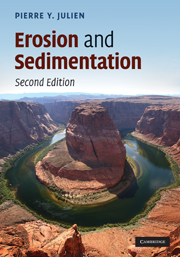Book contents
- Frontmatter
- Contents
- Preface
- List of Symbols
- 1 Introduction
- 2 Physical properties and dimensional analysis
- 3 Mechanics of sediment-laden flows
- 4 Particle motion in inviscid fluids
- 5 Particle motion in Newtonian fluids
- 6 Turbulent velocity profiles
- 7 Incipient motion
- 8 Bedforms
- 9 Bedload
- 10 Suspended load
- 11 Total load
- 12 Reservoir sedimentation
- Appendix A Einstein's Sediment Transport Method
- Appendix B Useful mathematical relationships
- Bibliography
- Index
2 - Physical properties and dimensional analysis
Published online by Cambridge University Press: 05 June 2012
- Frontmatter
- Contents
- Preface
- List of Symbols
- 1 Introduction
- 2 Physical properties and dimensional analysis
- 3 Mechanics of sediment-laden flows
- 4 Particle motion in inviscid fluids
- 5 Particle motion in Newtonian fluids
- 6 Turbulent velocity profiles
- 7 Incipient motion
- 8 Bedforms
- 9 Bedload
- 10 Suspended load
- 11 Total load
- 12 Reservoir sedimentation
- Appendix A Einstein's Sediment Transport Method
- Appendix B Useful mathematical relationships
- Bibliography
- Index
Summary
The processes of erosion, transport, and deposition of sediment particles introduced in Chapter 1 relate to the interaction between solid particles and the surrounding fluid. This chapter describes physical properties of water and solid particles in terms of dimensions and units (Section 2.1), physical properties of water (Section 2.2) and of sediment (Section 2.3). The method of dimensional analysis (Section 2.4) is then applied to representative erosion and sedimentation problems.
Dimensions and units
The physical properties of fluids and solids are usually expressed in terms of the following fundamental dimensions: mass (M), length (L), time (T), and temperature (T°). The fundamental dimensions are measurable parameters which can be quantified in fundamental units.
In the SI system of units, the basic units of mass, length, time, and temperature are the kilogram (kg), the meter (m), the second (s), and the degree Kelvin (°K), respectively. Alternatively, the Celsius scale (°C) is commonly preferred with the freezing point of water at 0°C, and the boiling point at 100°C.
A newton (N) is defined as the force required to accelerate one kilogram at one meter per second squared. Knowing that the acceleration due to gravity at the Earth's surface g is 9.81 m/s2, the weight of a kilogram is obtained from Newton's second law: F = mass × g = 1 kg × 9.81 m/s2 = 9.81N. The unit of work (or energy) is the joule (J) which equals the product of one newton times one meter.
- Type
- Chapter
- Information
- Erosion and Sedimentation , pp. 4 - 27Publisher: Cambridge University PressPrint publication year: 2010



